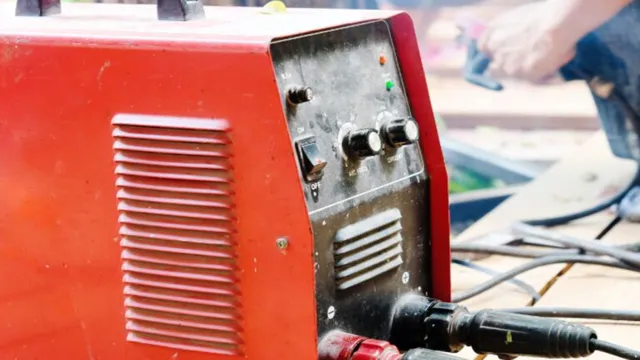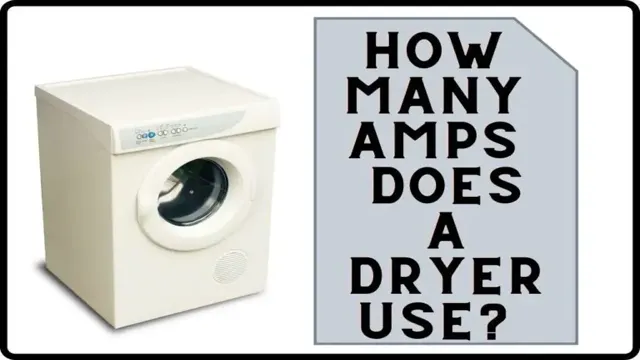How to Improve Power Factor of Welding Machine for Increased Efficiency

If you’re a welder, then you can attest that welding machines are a crucial tool for your profession. However, every machine has its drawbacks, and welding machines are no exception. One common drawback that welding machines face is their poor power factor, which can lead to inefficiencies, increased costs, and even damaged equipment.
Luckily, there are various ways to improve the power factor of your welding machine, and this blog post is here to guide you through them. From adjusting the input voltage to upgrading your equipment, we’ve got you covered. So, sit back, relax, and read on to learn more about improving the power factor of your welding machine.
Understanding Power Factor
Improving the power factor of a welding machine can help save energy and reduce energy costs. Power factor is the ratio of the real power used by an electrical system to the apparent power. A lower power factor means more energy is wasted, increasing energy bills and reducing the efficiency of electrical systems.
To improve the power factor of a welding machine, one can add capacitors to the circuit, which increase the reactive power of the system and reduce the amount of wasted energy. Another way to improve power factor is by ensuring that the machine is not overloading the power supply, as this can result in a low power factor. By taking these steps, one can significantly improve the power factor of their welding machine and reduce energy costs while maintaining the efficiency of their electrical systems.
Definition and Formula of Power factor
Power factor Power factor is an essential concept to understand when working with electrical systems. It is a measure of how efficiently the electrical power is being used. Power factor is expressed as a ratio between the active power and the apparent power in an AC circuit.
The active power is the actual power being used to perform work, while the apparent power is the total power being supplied to the circuit. A power factor of 1 indicates that all of the supplied power is being used to perform work. A power factor less than 1 indicates that some of the supplied power is being wasted.
To calculate power factor, divide the active power by the apparent power. Power factor has a significant impact on the efficiency of electrical systems. By improving power factor, energy costs can be reduced, and the overall efficiency of the system can be improved.

Importance of Power factor in Welding Machines
Power factor, Welding Machines When it comes to welding machines, power factor is a crucial factor that needs to be understood. Simply put, power factor refers to the ratio of real power (measured in watts) used by the machine to the apparent power (measured in volt-amperes) supplied to it. A power factor of 1 means that all the power supplied to the machine is converted into useful work, while a power factor of less than 1 indicates that some of the energy is lost as reactive power.
This not only leads to a decrease in efficiency but also results in higher energy consumption, leading to increased utility bills. Therefore, it is important to ensure that your welding machine has a high power factor, which will not only save you money but also ensure optimal performance. In conclusion, the power factor is a critical factor that cannot be ignored when it comes to welding machines and should be understood and optimized for maximum efficiency and economy.
Causes of Poor Power Factor in Welding Machines
Improving the power factor of welding machines is crucial for efficient and cost-effective welding operations. Poor power factor is mainly caused by inductive loads such as motors and transformers, which are found in welding machines. In simpler terms, the current is lagging behind the voltage resulting in a waste of energy and the need for higher current levels.
Some common causes of poor power factor include undersized cables, long cables, and the use of outdated or low-powered welding machines. Depending on the situation, one way to improve the power factor of welding machines is by adding capacitors to introduce a counter-balancing reactive power to stabilize the current and voltage levels, thereby improving power factor. Another way is to use new, high-powered welding machines with high efficiency ratings that optimize power factor.
Overall, improving power factor in welding machines translates into reduced energy costs, increased equipment longevity, and enhanced performance.
Inductive Load and Reactive Power
Poor Power Factor in Welding Machines Welding machines are known to consume a significant amount of power and operate at poor power factors due to the inductive load of their transformers and other components. Transformers draw reactive power, which causes the current and voltage to go out of phase, leading to a low power factor. Additionally, the use of AC motors in welding machines also contributes to the poor power factor.
Other factors that can cause poor power factor in welding machines include faulty capacitors, old equipment, and inappropriate wiring. Thus, it is essential to ensure that welding machines are appropriately sized, properly maintained, and regularly inspected to minimize the impact on the power grid, reduce electricity bills, and lower carbon footprints.
Capacitive Load and Capacitive Power
When it comes to welding machines, poor power factor can be caused by a variety of factors. One of the main culprits is capacitive load. This occurs when the welding machine has a high capacitive power, meaning it draws more current than it needs to operate efficiently.
This can result in inefficiencies in power usage, leading to higher costs and poorer performance. Another issue that can contribute to poor power factor is inductance, which is caused by magnetic fields created by components in the welding machine. By understanding these factors and taking steps to mitigate them, welders can improve the power factor of their machines and achieve better results.
From adjusting current levels to reducing capacitance, there are many steps that can be taken to address power factor issues in welding machines and improve overall performance.
Effects of Poor Power Factor on Welding Machines and Environment
Poor power factor is a common problem in welding machines that can have significant effects on both the equipment and the environment. One of the main causes of poor power factor is the use of motor-driven equipment, such as fans or pumps. When these machines are not in use, they still consume power, resulting in wasted energy and inefficient use of resources.
Another possible cause of poor power factor in welding machines is the use of oversized or undersized electrical equipment. This can lead to an imbalance in the electrical system and cause fluctuations in voltage, resulting in reduced efficiency and increased energy consumption. As a result, welding machines with poor power factor generate more heat and produce a greater amount of exhaust fumes, contributing to environmental pollution.
Regular maintenance and upgrades can help improve power factor, resulting in a more efficient, cost-effective, and environmentally-friendly welding process.
Ways to Improve Power Factor of Welding Machines
If you’re experiencing power factor problems with your welding machines, there are several ways to improve it. The first step is to check the power factor of your machine regularly. This will allow you to determine the extent of the problem and the necessary steps to take for improvement.
One of the most effective ways to improve your welding machine’s power factor is by adding a capacitive load bank to the system. This will help balance the reactive power and reduce the amount of current required from the utility. Another way is by upgrading the power factor correction capacitors in the system to ensure a more efficient power transfer.
Lastly, make sure to maintain your welding equipment regularly, including cleaning and checking connections, which can affect the power factor. Improving the power factor of your welding machines not only saves energy costs but also ensures a longer lifespan of the equipment.
Use of Capacitors and Power Factor Correction Units
Power factor correction units Welding machines are widely used in many industries, but they can cause some problems with power factor. Power factor is the ratio of the real power used by a device, such as a welding machine, to the apparent power drawn from the power source. A low power factor means that the machine is not effectively using the power being supplied, leading to an increased load on the power source.
To improve the power factor of welding machines, one can use capacitors and power factor correction units. Capacitors can store energy and release it when needed, which can help to stabilize voltage and reduce current fluctuations. Power factor correction units can also be used to optimize the power factor of the welding machine by controlling the amount of reactive power used.
With these improvements, the welding machine can operate more efficiently and effectively, reducing costs and minimizing negative impacts on the power source. So, if you are looking for ways to enhance the performance of your welding machine, consider using capacitors and power factor correction units to improve its power factor and optimize its power usage.
Proper Maintenance of Welding Machines
Proper Maintenance of Welding Machines Welding machines are used extensively in various industries, from manufacturing to construction. To ensure the safety and efficiency of these machines, proper maintenance is crucial. One aspect that requires attention is the power factor of welding machines.
Power factor is a measure of how efficiently the machine is using electrical power. A low power factor can lead to increased energy consumption, reduced efficiency, and higher operational costs. To improve the power factor of welding machines, several steps can be taken.
One such step is to ensure that the machine is correctly grounded. Another step is to use high-quality cables and connectors that can handle the high electrical loads generated during welding operations. Regular maintenance, including cleaning and lubrication of moving parts, can also contribute to prolonging the lifespan of the machine.
By taking these measures, welding machine operators can ensure that their equipment works reliably, safely, and efficiently, thereby improving productivity and reducing costs in the long run.
Choosing the Right Size of Power Factor Correction Equipment
Improving power factor for welding machines is crucial for any business that uses this equipment extensively. One of the most effective ways to do this is by installing power factor correction equipment that’s suitable for the size of the welding machine. Choosing the right equipment requires taking into consideration several factors like the reactive power requirement of the machine, the load current, and the voltage level.
It’s important to ensure that the equipment isn’t undersized as this could result in reduced efficiency, frequent breakdowns, and increased energy bills. Similarly, oversizing the power factor correction equipment may mean investing more than necessary. To determine the right size of power factor correction equipment, you need to consult a qualified electrician who will assess your welding machine’s power needs and recommend the most appropriate equipment.
With the right power factor correction equipment in place, your welding machine can operate more efficiently, consume less energy, and be more reliable, saving you money in the long run.
Conclusion
In conclusion, improving the power factor of your welding machine can greatly benefit both your wallet and the environment. By reducing energy waste and keeping your electricity bills in check, you’ll have more resources to invest in your craft and create stunning metalwork. So, don’t let a low power factor zap your creativity and productivity – take the necessary steps to boost it and become a true welding wizard!”
FAQs
What is power factor in welding machines?
Power factor is the ratio of the real power used to do work (welding) to the input power that the welding machine draws from the power source. A power factor of 1.0 means all of the power drawn from the source is used for welding, whereas a power factor less than 1.0 means some power is wasted.
Why is it important to improve power factor in welding machines?
Improving power factor can result in significant cost savings and increased efficiency. A low power factor means that more energy is needed from the power source to achieve the same welding output, which can lead to higher electricity bills and decreased productivity.
How can I measure the power factor of my welding machine?
You can use a power factor meter to measure the power factor of your welding machine. This device will measure and display the power factor and other electrical parameters of the machine.
What are some common causes of low power factor in welding machines?
Some common causes of low power factor include the use of inefficient power supplies, mismatched power sources and welding machines, and poor electrical connections.
What are some techniques that can be used to improve power factor in welding machines?
Techniques to improve power factor include using a power factor correction device, using efficient power supplies, selecting the correct size of welding machine for the job, and improving electrical connections.
How does a power factor correction device work?
A power factor correction device works by correcting the phase difference between the voltage and current drawn by the welding machine, ensuring that the machine draws power from the source more efficiently and with less waste.
Can improving power factor also lead to better weld quality?
Yes, improving power factor can lead to better weld quality and consistency. With more efficient use of power, welding machines will operate more reliably and produce more consistent welds with less spatter and defects.







